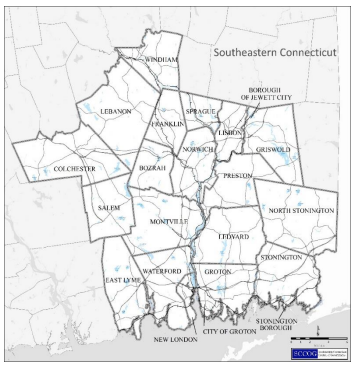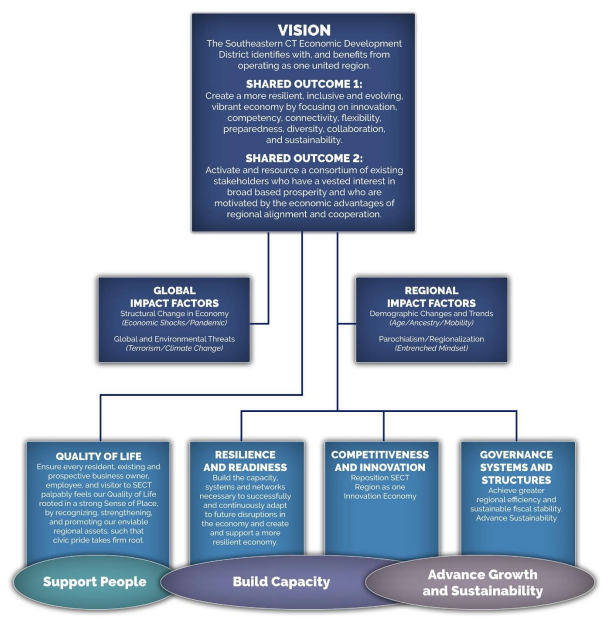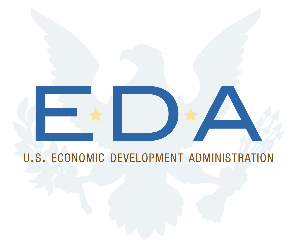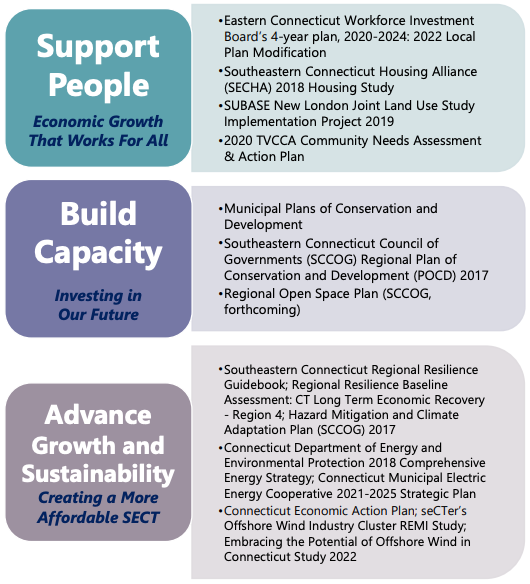Summary Background
INTRODUCTION
The Southeastern Connecticut Enterprise Region (seCTer) is a nonprofit, public-private regional economic development agency serving the 20 towns, two boroughs, and Native American Tribal Nations of Southeastern Connecticut. The seCTer region, also known as an economic development district (EDD), is coterminous with New London County with ethe following exceptions: 1) the region includes the Town of Windham, which is in Windham County, and 2) the region excludes three New London County municipalities: Lyme, Old Lyme and Voluntown (Figure 1).
The mission of seCTer is to promote and preserve the region’s attractiveness, to encourage new businesses, and to assist and nurture existing and expanding local enterprises. seCTer is the agency responsible for developing and implementing the Comprehensive Economic Development Strategy (CEDS) for the Southeastern CT Economic Development District, in close partnership/coordination with the Southeastern CT Council of Governments (SCCOG) and other regional organizations. This document is an update to the 2017 Comprehensive Economic Development Strategy (CEDS 2017).¹

Figure 1
The 22 cities, towns and boroughs that comprise the seCTer EDD consist of urban, suburban and rural areas with a 2020 population of 279,918 spread along the shoreline of Long Island Sound and inland along the Thames, Shetucket, Quinebaug and Yantic Rivers.
In the absence of county government, each municipality provides its own government services and is a member of the SCCOG. Sixty-four (64) census tracts make up the region, eight of which are federally-designated Opportunity Zones. The EDD does not align with county borders and includes all but three towns in New London County and one municipality in Windham County. Of the 20 municipalities in the EDD, eight appear on Connecticut’s 2022 Distressed Municipalities List, including three among the top five most distressed municipalities. For a region with under 8 percent of the state’s population, it bears a disproportionate 32 percent of the state’s distressed municipalities, a historical factor which led in great part to the region being officially designated an Economic Development District in 2011.
¹ seCTer’s CEDS 2017 is recognized by the National Association of Development Organizations (NADO) and presented on its webpage as one of nine CEDS Spotlight case studies (CEDS Spotlight: Southeastern Connecticut Enterprise Region – NADO). Through these case studies, NADO highlights best practices and innovative elements of CEDS planning, development and implementation from EDDs and other regional development organizations across the country.
The purpose of CEDS 2023 is to provide direction, focus and a framework from which to proceed and to which local plans can align to gain validity and strength. CEDS 2023 provides flexible strategies able to adapt to both macro- and micro-economic conditions and allow full utilization of the region’s unique advantages to maximize economic opportunity for its residents.
The goals − Support People, Build Capacity, and Advance Growth and Sustainability, key strategies and activities identified in CEDS 2023 are directly linked to existing regional plans (Figure 2) and the region’s previous priority strategies presented in CEDS 2017 (Table 1). This structure allows the region to evolve and develop new areas of focus, while maintaining historically important key focus areas.
The Regional Vision, broad objectives and flexible framework for implementation developed for CEDS 2017 remain relevant today. However, the Covid-19 pandemic revealed inequities in the region and economy with respect to healthcare, housing, funding, employment, and basic goods and services. To address these inequities, CEDS 2023 has aligned with the State of Connecticut’s vision for an equitable and healthy recovery by identifying opportunities to collaborate and create a more equitable, supportive economy that everyone can participate in.
The cornerstone of CEDS 2023 is the three unique but mutually supportive goals: 1) Support People, 2) Build Capacity, and 3) Advance Growth and Sustainability. These three goals are linked to the seven key strategies in CEDS 2017 (Table 1). Thus, the past informs the present: CEDS 2023 is intricately linked to CEDS 2017, yet presents its own priorities and strategies for the seCTer region and economy
Table 1
Support People
- Ensure every resident, existing and prospective business owner, employee and visitor to SECT has access to and palpably feels our quality of life tied to a strong place, by recognizing, strengthening and promoting our enviable regional assets, such that civic pride takes firm root.
- Identify and work to resolve any disparities and challenges impacting economic and community development related to each of the five components of the transportation network (transportation infrastructure; motor vehicles and containers; mobile workforce; propulsion system and power supply; and operation).
Build Capacity
- Build (expand) the capacity, systems and networks necessary to successfully and continuously adapt to future disruptions in the economy and create and support a more inclusive, resilient economy.
- Reposition SECT region as one innovation economy by continually transforming our current systems, structures and physical landscapes into those that are aligned, inclusive, supportive and innovative.
Figure 2
- Invest in tools needed to transition from an educational system designed for the industrial age to a system designed for the future business needs and that focuses on preparedness, competency, inclusivity, diversity and creativity.
Advance Growth & Sustainability
- Achieve greater regional efficiency through equitable and sustainable fiscal policy.
- Engage in collaborative efforts to identify the largest regional vulnerabilities, and share resources (planning, engineering, and monetary resources) to enhance regional resilience.
As the world continues to live through and recover from the Covid pandemic, EDDs across the nation are considering creative and innovative methods to improve their respective region’s resilience to shocks and disruptions. While not directly focused on job retention and creation, CEDS plays a key role in facilitating economic prosperity by building awareness, inspiring action and identifying the resources needed to open up pathways to success.
The social disruption and unrest during the pandemic period also demonstrated both the need to emphasize and clearly articulate the benefits of equitable economic disbursal throughout society and the perils of ignoring same. Underlying inequities were exacerbated by the pandemic which impacted unevenly along lines of race, age, class, gender and disability. CEDS 2023 is developed through a lens of resiliency, equity and opportunities for alignment in recognition that all three elements are key components of a stronger and more prosperous region (Table 2).
Figure 3 illustrates how CEDS 2017 shared outcomes are still relevant today. Shared Outcomes 1 and 2 are reversed to place greater emphasis on resilience and inclusivity, as well as introducing the overarching goals of Support People, Build Capacity and Advance Growth and Sustainability. Economic development takes time, and it is important to understand how priorities evolve after large economic shocks such as a pandemic.
CEDS 2023 meets the requirements set forth in 13 C.F.R. § 303.7 and updates CEDS 2017 and all prior updates and project lists. CEDS 2023 has been approved by seCTer, the Southeastern Connecticut Council of Governments (SCCOG), the State of Connecticut Department of Economic and Community Development (DECD), Connecticut Office of Policy Management (OPM), and the U.S. Department of Commerce, Economic Development Administration (EDA).
Table 2

Figure 3. CEDS 2023 Vision and Shared Outcomes.
The Comprehensive Economic Development Strategy 2023-2027 (CEDS 2023) is a publication of Southeastern Connecticut Enterprise Region (seCTer). It meets requirements set forth in 13 C.F.R. § 303.7 and updates CEDS 2017 and all prior updates and project lists. CEDS 2023 is approved by seCTer, the Southeastern Connecticut Council of Governments (SCCOG), the State of Connecticut Department of Economic and Community Development (DECD), Connecticut Office of Policy Management (OPM), and the U.S. Department of Commerce, Economic Development Administration (EDA).

Acknowledgements
Thank you to the following people for their significant contributions.
CEDS Oversight Committee
David Hammond, seCTer Economic Development Committee
Catherine Young, seCTer Economic Development Committee
Juliet Hodge, Director of Land Use and Planning, Town of Ledyard
Sean Nugent, seCTer, Board Chair
Mark Oefinger, seCTer, Board Chair Emeritas
seCTer Staff
Paul Whitescarver, Executive Director
R.T. Hamilton Brown, Director
Contributors
Juliet Hodge – Director of Land Use and Planning, Town of Ledyard Sagax Associates
Rick Domas, Windsor Editing

